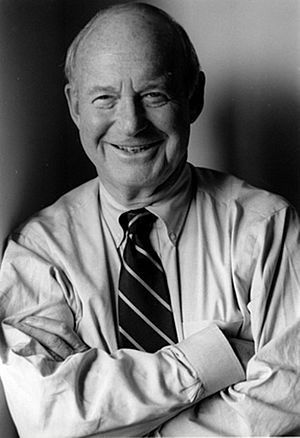Gerald Weissmann facts for kids
Quick facts for kids
Gerald Weissmann
|
|
|---|---|

Gerald Weissmann
|
|
| Born | August 7, 1930 |
| Died | July 10, 2019 (aged 88) |
| Nationality | American |
| Alma mater | Columbia University New York University School of Medicine |
| Known for | Complement system Inflammation Rheumatoid arthritis Systemic lupus erythematosus Liposome |
| Spouse(s) | Ann (Raphael) Weissmann (2 children) |
| Awards | Royal Society of Medicine American College of Rheumatology New York Academy of Medicine New York Academy of Sciences American Academy of Arts and Sciences |
| Scientific career | |
| Fields | Immunology Rheumatology Medicine |
| Institutions | Mount Sinai Hospital (Manhattan) Medical Corps (United States Army) Strangeways Research Laboratory Marine Biological Laboratory Élan New York University School of Medicine |
Gerald Weissmann (born August 7, 1930 – died July 10, 2019) was an amazing American doctor, scientist, writer, and editor. He was born in Austria but became an American citizen. He taught medicine at New York University School of Medicine. He was also the main editor of The FASEB Journal for ten years. In 1965, he helped discover tiny bubbles called liposomes and even helped name them!
Contents
Early Life and Education
Gerald Weissmann was born in Vienna, Austria, on August 7, 1930. His parents were Adolf and Greta Weissmann. His family was Jewish, and they had to leave Austria in 1938 to escape the Nazis. They moved to the United States, and Gerald became an American citizen in 1943.
He went to the Bronx High School of Science. Then, he studied at Columbia University, getting his first degree in 1950. He later earned his medical degree from New York University in 1954. Before becoming a full-time scientist, he also showed his art in a big gallery in New York.
His Career in Medicine and Science
After finishing his medical training, Dr. Weissmann worked as a captain in the U.S. Army Medical Corps. He then joined a research team at NYU, working with a Nobel Prize winner named Severo Ochoa. He also worked at the Strangeways Research Laboratory in England, where he studied how cells work.
In 1962, he returned to New York University School of Medicine. He stayed there for the rest of his career. He also visited other famous research centers in England and France.
Discoveries in Rheumatology
Dr. Weissmann became a Professor of Medicine at NYU in 1970. He led the Rheumatology department for many years. Rheumatology is the study of diseases that affect joints, muscles, and bones.
He was famous for showing that rheumatoid arthritis is a disease where the body's immune system attacks itself. He also found that problems in systemic lupus erythematosus (another immune disease) happen because of a process called complement activation in the blood. His work helped us understand how the body's defense system can sometimes cause harm.
The Discovery of Liposomes
One of Dr. Weissmann's biggest achievements was helping to discover liposomes in 1965. He is even credited with coining the name "liposome." Liposomes are like tiny, hollow bubbles made of fats. They are very important in medicine today.
He helped start a company called The Liposome Company. Two medicines based on his liposome work, Abelcet and Myocet, are used in hospitals. Liposomes are now known as a very successful way to deliver medicines inside the body.
Awards and Recognition
Dr. Weissmann received many awards for his important work. He was honored by groups like the American College of Rheumatology and the Royal Society of Medicine in London. He was also a member of the American Academy of Arts and Sciences. He helped guide important science programs, like the Pew Scholars in Biomedical Sciences.
Editor and Writer
Besides his scientific work, Dr. Weissmann was also a talented editor and writer. He was the founding editor of the journal Inflammation for many years. He also edited MD Magazine and was the main editor of The FASEB Journal.
His Essays and Books
Dr. Weissmann was a member of PEN America, a group that supports writers. He wrote many essays and reviews about history and culture. His writings appeared in well-known magazines like The New Republic and The New York Times Book Review.
He published eleven books of his essays. Some of his books include The Woods Hole Cantata and The Fevers of Reason. Famous people like scientist Jonas Salk and writer Kurt Vonnegut praised his work for its scientific ideas and great writing style.
- The Woods Hole Cantata (1985) ISBN: 9780396086185
- They All Laughed at Christopher Columbus (1987) ISBN: 9780812916188
- The Doctor With Two Heads (1990) ISBN: 9780679733911
- The Doctor Dilemma (1992) ISBN: 9781879736054
- Democracy and DNA (1995) ISBN: 9780809093052
- Darwin's Audubon (2002) ISBN: 9780738205977
- The Year of the Genome (2002) ISBN: 9780805072921
- Galileo's Gout: Science in an Age of Endarkenment (2007) ISBN: 9781934137000
- Mortal and Immortal DNA (2009) ISBN: 9781934137161
- Epigenetics in the Age of Twitter (2012) ISBN: 9781934137390
- The Fevers of Reason (2018) ISBN: 9781942658320
Personal Life
Gerald Weissmann married Ann Raphael in 1953. They had two children: Lisa Beth Weissmann, who is also a doctor, and Andrew Weissmann, who is a respected legal expert.
Death
Gerald Weissmann passed away on July 10, 2019.

